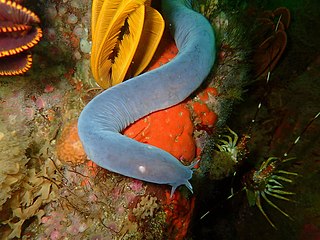
Hagfish, of the class Myxini and order Myxiniformes, are eel-shaped jawless fish. Hagfish are the only known living animals that have a skull but no vertebral column, although they do have rudimentary vertebrae. Hagfish are marine predators and scavengers who can defend themselves against other larger predators by releasing copious amounts of slime from mucous glands in their skin.

The ladyfish or tenpounder is a species of fish in the genus Elops, the only genus in the monotypic family Elopidae.

The broadgilled hagfish or New Zealand hagfish, also known by its Māori language name tuere, is a hagfish found around New Zealand and the Chatham Islands as well as around the south and east coasts of Australia, at depths between 1 and 900 metres.

The mojarras are a family, Gerreidae, of fish in the order Perciformes. The family includes about 53 species found worldwide in tropical and warm temperate regions. They mostly inhabit coastal salt and brackish waters, although some occur in fresh water.

Oplegnathus is currently the sole recognized genus in the knifejaw family (Oplegnathidae) of marine centrarchiform ray-finned fishes. The largest, the Cape knifejaw, can reach a maximum length around 90 cm (35 in). Knifejaws have teeth fused into a parrot-like beak in adulthood. They feed on barnacles and mollusks, and are fished commercially. They are native to the Indian and Pacific Oceans.

The Pacific hagfish is a species of hagfish. It lives in the mesopelagic to abyssal Pacific Ocean, near the ocean floor. It is a jawless fish and has a body plan that resembles early Paleozoic fishes. They can excrete copious amounts of slime in self-defense.

Eptatretus is a large genus of hagfish.

The shortnose gar is a primitive freshwater fish of the family Lepisosteidae. It is native to the United States where its range includes the Mississippi and Missouri River basins, ranging from Montana to the west and the Ohio River to the east, southwards to the Gulf Coast. It inhabits calm waters in large rivers and their backwaters, as well as oxbow lakes and large pools. It is a long, slender fish, brown or olive green above and whitish below. It typically grows to about 60 cm (24 in) and is armored by rows of interlocking, rhomboidal ganoid scales.

Fish are very diverse animals and can be categorised in many ways. Although most fish species have probably been discovered and described, about 250 new ones are still discovered every year. According to FishBase about 34,800 species of fish had been described as of February 2022, which is more than the combined total of all other vertebrate species: mammals, amphibians, reptiles and birds.

The inshore hagfish is a hagfish found in the Northwest Pacific, from the Sea of Japan and across eastern Japan to Taiwan. It has six pairs of gill pouches and gill apertures. These hagfish are found in the sublittoral zone. They live usually buried in the bottom mud and migrate into deeper water to spawn. The inshore hagfish is the only member of the Myxinidae family having a seasonal reproductive cycle.

Myxine is a genus of hagfish, from the Greek μυξῖνος. It is the type genus of the class Myxini.

The southern hagfish is a hagfish of the genus Myxine.
Eptatretus bischoffii is a common hagfish of the genus Eptatretus. Its maximum length is 55 centimetres (22 in). It lives in a demersal, non-migratory, marine habitat with its depth range between 8–50 m. It can survive in only temperate zones. These organisms are found in the South Pacific, mainly, Chile. It is harmless to humans.

Myxine glutinosa, also known as the Atlantic hagfish, is a type of jawless fish belonging to the class Myxini..

Eptatretus deani, the black hagfish, is a species of hagfish.

Cycleptus is a genus of freshwater fish containing two relatively large North American species of suckers. They are endemic to river basins draining into the Gulf of Mexico, including the Mississippi, Rio Grande and others in the United States and Mexico.
Nemamyxine is a genus of hagfish.
Rubicundus is a genus of hagfishes, the only extant member of the subfamily Rubicundinae. All species in it were formerly classified in Eptatretus. R. eos, R. lakeside, and R. rubicundus are known from single specimens caught in the Tasman Sea, Galápagos, and Taiwan, respectively. They are named after the distinctive red coloration that all species share.

Eptatretus hexatrema, the sixgill hagfish, or snotslang is a species of marine fish in the hagfish family of order Myxiniformes. It is native to the South Atlantic Ocean and southwestern Indian Ocean.

Eptatretus polytrema, the fourteen-gill hagfish or Chilean hagfish, is a demersal and non-migratory hagfish of the genus Eptatretus. It is found in muddy and rocky bottoms of the southeastern area of the Pacific Ocean near the coast of Chile between Coquimbo and Puerto Montt, at depths between 10 and 350 m. This hagfish can reach a length of 93 cm. It is only known from a few specimens and has not been recorded since 1988.













